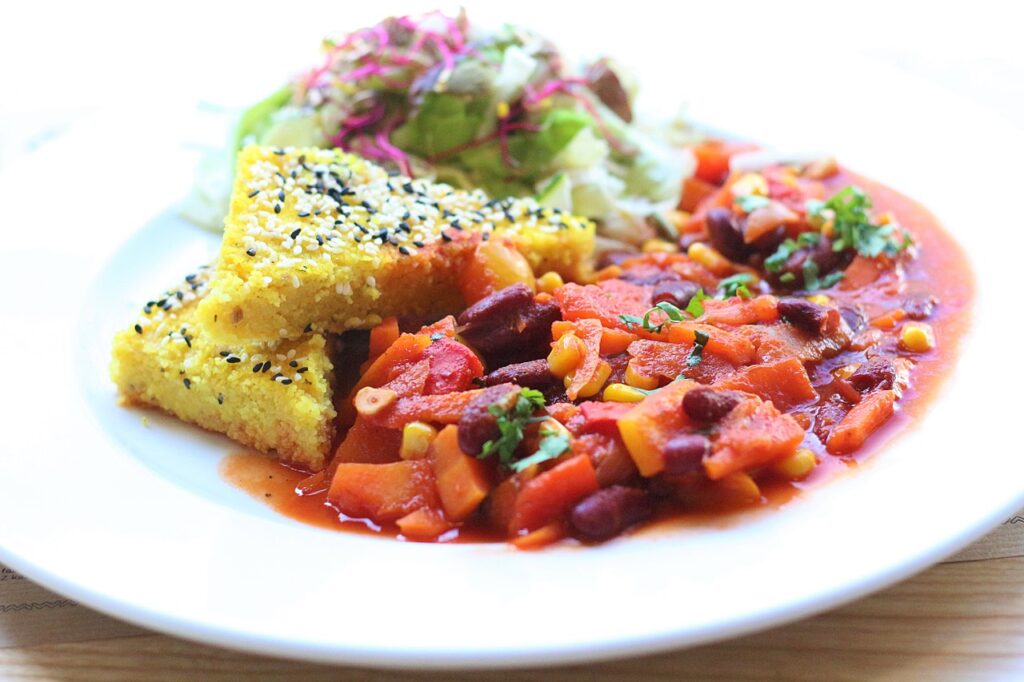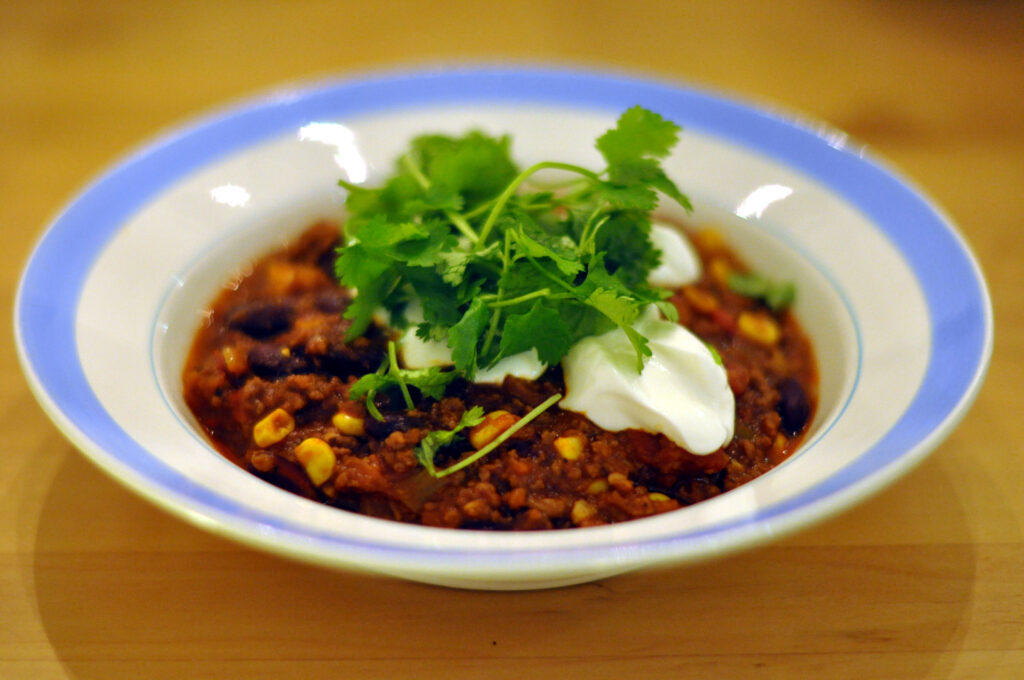The best tips and tricks for classic and vegetarian chili con carne
The thought of a hot steaming chili con carne inevitably makes my mouth water and a comforting warmth spread. “Chili with meat” – that’s a simple translation from Spanish, but there are numerous myths and wild stories surrounding the origin of this popular stew. Even the U.S. states of Texas, New Mexico, and Arizona are still busy debating where chili con carne was invented.
Today we go in search of the original recipe for the stew and tell you how to cook the perfect chili con carne step by step and which mistakes you should avoid. One of the important: how long to let the chili simmer.
Chili con Carne – The original recipe
Many people think that chili con carne would be a Mexican dish, but our journey takes us to Texas.
In the 19th century, it was mostly adventurers and cowboys who shared the dish as a warming source around the campfire. Dried beef, chilies, a few spices, and a bit of fat always fit in saddlebags and were cheap ingredients that kept well. The latter also made the dish a staple of prison food and, later, the crew supply for Army troops in the many battles.
After the end of the Civil War in the USA, there was no stopping the mass success of the firepot. It was the chili queens who lined the marketplaces of San Antonio, Texas, who made it. The original Texas recipe is a simple affair of beef, dried chilies, broth, and lots and lots of time. Few ingredients, but carefully selected and prepared – that’s what it’s all about. So let’s take a closer look at the individual ingredients for your perfect chili.

Cooking chili con carne – step by step
The right pod
Ideally, the chili flavor of the meat stew should be composed of a good mix of the four different chili flavors. There are the sweet, fresh chilies such as the New Mexico variety Anaheim, the hot tearjerkers such as Pequin or Arbol, smoked varieties such as Chipotles, and types with particular often fruity flavors for example the Anchos reminiscent of plums and tobacco.
Depending on the heat sensation and preferences, each chili lover can find his personal balance. A good selection of dried chilies is available at Latino stores or online. The pods can be ground quite well in a blitz chopper or mortar – the powder doesn’t even have to be super fine, because the fruit fibers dissolve on their own during long cooking. In the original recipe from Texas, the dried pods are even cooked whole with the meat and the strong beef broth until soft.
The right meat
The second important element of any chili is the “carne” part. True to the original, beef goes into the pot – well-suited for the slow-simmered dish are marbled cuts such as the neck, shoulder, upper and lower skins. These are cut into large cubes and seared hot before being combined with the other ingredients in the pot for several hours. Outside of Dallas, Phoenix, and Albuquerque, many cooks have lent a hand to the original recipe, expanding, simplifying, and changing it. In addition to recipes with beef, there is now almost every meat variety from pork and turkey to venison, wild boar, and rabbit.
In addition, many people prefer to use minced meat rather than large pieces, as it greatly reduces the preparation time. However, you should keep in mind not to use lean meat.

From vegetables and spices to secret ingredients
Besides meat and chili, there is a lot of freedom. The great thing about chili is that everyone can make it exactly the way they like it: spicy, mild, with or without beans, with additional vegetables and spices of their choice. For me, beans are an absolute must, as well as onions and garlic as aromatics. But you can also add corn, grated carrot, or even sun-dried tomatoes to taste.
In terms of spices, you can use dried oregano, rosemary, and thyme, as well as bay leaves and cumin – here, too, everything is allowed that tastes good. Personally, I like it simple and use only black beans, which I add to the pot ready and well-drained from the can.

Ready-mixed spice powders are of course tempting, but if you love your chili, it’s best to mix it yourself. It’s not that complicated: pre-roast a few dried chilies of different flavors, good paprika powder (smoked if you like), and a teaspoon of cumin seeds in a warm pan to release their aroma, then grind them in a mortar or grinder.
Just as much as there is debate about the best recipe, there is also debate about secret ingredients. Some cooks use red wine or sherry, which makes the meat particularly nice and tender. Coffee and chocolate are also popular. I haven’t tried coffee myself yet, but a piece of dark chocolate does make its way into my chili pot from time to time. Speck can also be sautéed with the meat in small pieces.
With or without toppings?
The real chili fan needs no more than a spoonful to go with his steaming bowl. However, you can also try a dollop of sour cream or yogurt, freshly chopped cilantro, grated cheddar, scallion rings, avocado, or tortilla chips as toppings, or serve the chili with rice on the side.

Here’s how:
Chili is not a quick affair. Time is the magic ingredient par excellence that brings everything together: Slowly simmered, lovingly stirred several times, tasted, and if at all possible even left to rest overnight, it’s what with the super chili. As with other slow-cooked dishes, the best way to cook chili con carne is to use a heavy casserole or a pan with a lid, the size of which is appropriate for the team you’re cooking with. Here is my personal favorite recipe for chili con carne:
- Peel and finely dice onions and garlic. Add a generous portion of olive oil and the meat of choice to the pot. It is important that the meat is seared vigorously and browned. Therefore, if the quantity is very large, it may be necessary to sear the meat in portions.
- Once the meat is well browned, add the onions and garlic to the pot and sauté. Now it’s also time for the chilies: sprinkle the ground chili mixture over the meat and sauté briefly.
- Now follow beans and according to taste further vegetables and other spices. The whole thing is now filled with tomato passata or chunky tomatoes from the can and strong meat broth in a ratio of 2:1 so that beans and meat are well covered. Finally, add a pinch of salt to the pot, put the lid on at a slight angle, and turn down the temperature. Let it simmer for an hour, stirring occasionally.
- The chili is ready when the liquid is well reduced and thickened. A few popped beans are also a good sign. Remove the pot from the heat at the end of the cooking time and let it rest for 20 minutes before serving with toppings to taste.
Chili sin Carne: cooking vegetarian chili con carne.
Of course, vegetarians and vegans do not want to give up the one-pot recipe and become inventive. Suitable animal substitutes include granulated soy, red, brown, and green lentils, crumbled seitan, sweet potatoes, quinoa, or simply extra vegetables in the original recipe.
Chili sin Carne

Basically, the preparation tips and tricks also apply to vegetarian versions. Since vegetables, unlike meat, often absorb heat less, seasoning should be done carefully and in stages. To get as much roasted flavor as possible in the pot, onion, bell pepper and co. should be roasted slowly and at medium temperature until they have a lot of colors. Only then follow the rest of the ingredients.
Tell us in the comments how you prefer to eat chili con carne or upload your favorite chili con carne, or even chili sin carne recipe via our app. We look forward to your recipes!

